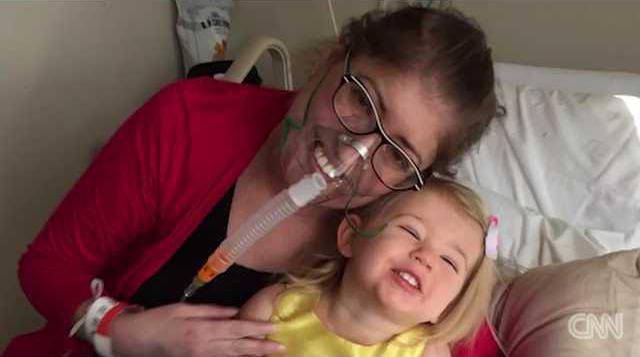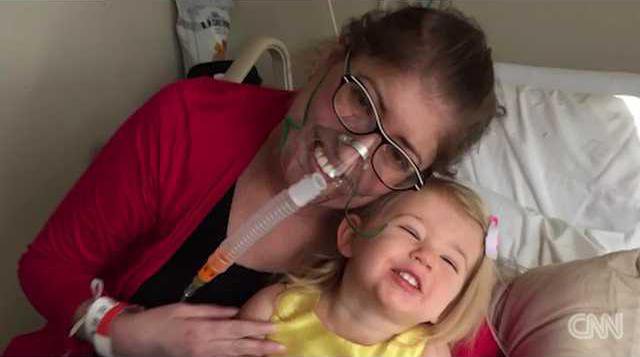What was supposed to be a routine trip to the hospital turned into a life-changing procedure for one mother. Melissa Benoit, 32, has cystic fibrosis, a genetic disorder that can cause a buildup of mucus in the lungs, pancreas and other organs. Over time, this condition can limit the ability to breathe. She had been taking antibiotics, but when she caught the flu, her coughing fits were so bad that she fractured her ribs, according to CNN.
The fatal problem
Benoit thought the doctors would just switch the antibiotics and allow her to head home, but she soon learned that the situation was much worse than she thought. Benoit was drowning in the blood and mucus that was filling her lungs, and she had been gasping for breath for days, according to CNN.
She was placed on a temporary life support, but her condition worsened. The doctors determined that she was becoming too sick for a lung transplant, so she was dropped from the list. We had reached the end of the road, said Dr. Shaf Keshavjee, one of surgeons attending Benoit. There was nothing we could do to keep her alive.
However, one of the doctors had been considering a procedure that might save Benoits life, but there was one setback: it had never been tried before.
This experimental surgery included removing both of lungs and keeping her on life support machines until donor lungs became available. This left the family with a difficult decision: they could agree to the procedure or she would pass away by morning.
Her husband, Chris Benoit, said in a news release that things were so bad for so long, we needed something to go right, and this new procedure was the first piece of good news in a long time. We needed this chance.
The risky procedure
With the familys approval, a team of thirteen worked on the nine-hour procedure. Her lungs were so full of mucus that they were as hard as footballs, Keshavjee said.
They removed her infected lungs and attached a portable artificial lung to her heart, according to The Washington Post. Another device helped circulate blood through her body.
Benoit was induced into a coma after the surgery, and she was kept alive by life support machines for six days. It was at that point that the hospital received a lung donation, and Benoit underwent a lung transplant, according to Today.
Benoit woke from her induced coma a few days following the successful transplant.
Keshavjee told The Washington Post that they saw positive signs from the procedure almost immediately. The fact that she got better so quickly was fantastic," Keshavjee said.
But the doctors werent the only ones who were hard at work. Benoit had a two-year-old daughter to fight for. "My real motivation was my daughter," Benoit said. Her family kept saying to her, Melissa look, theres Olivia, fight for Olivia.
From then to now
Benoit is doing physiotherapy to increase her strength. Since her procedure in April 2016, she spent months on the treadmill and lifting weights, and she doesnt need a cane or walker anymore. Now she can walk and dance with her daughter, she told Today.
As a mother with a chronic illness, she has her struggles. I think the most important thing is to remember that youre here, even though you have a chronic illness, Benoit said. Youre here, and for your child, you are enough.
The fatal problem
Benoit thought the doctors would just switch the antibiotics and allow her to head home, but she soon learned that the situation was much worse than she thought. Benoit was drowning in the blood and mucus that was filling her lungs, and she had been gasping for breath for days, according to CNN.
She was placed on a temporary life support, but her condition worsened. The doctors determined that she was becoming too sick for a lung transplant, so she was dropped from the list. We had reached the end of the road, said Dr. Shaf Keshavjee, one of surgeons attending Benoit. There was nothing we could do to keep her alive.
However, one of the doctors had been considering a procedure that might save Benoits life, but there was one setback: it had never been tried before.
This experimental surgery included removing both of lungs and keeping her on life support machines until donor lungs became available. This left the family with a difficult decision: they could agree to the procedure or she would pass away by morning.
Her husband, Chris Benoit, said in a news release that things were so bad for so long, we needed something to go right, and this new procedure was the first piece of good news in a long time. We needed this chance.
The risky procedure
With the familys approval, a team of thirteen worked on the nine-hour procedure. Her lungs were so full of mucus that they were as hard as footballs, Keshavjee said.
They removed her infected lungs and attached a portable artificial lung to her heart, according to The Washington Post. Another device helped circulate blood through her body.
Benoit was induced into a coma after the surgery, and she was kept alive by life support machines for six days. It was at that point that the hospital received a lung donation, and Benoit underwent a lung transplant, according to Today.
Benoit woke from her induced coma a few days following the successful transplant.
Keshavjee told The Washington Post that they saw positive signs from the procedure almost immediately. The fact that she got better so quickly was fantastic," Keshavjee said.
But the doctors werent the only ones who were hard at work. Benoit had a two-year-old daughter to fight for. "My real motivation was my daughter," Benoit said. Her family kept saying to her, Melissa look, theres Olivia, fight for Olivia.
From then to now
Benoit is doing physiotherapy to increase her strength. Since her procedure in April 2016, she spent months on the treadmill and lifting weights, and she doesnt need a cane or walker anymore. Now she can walk and dance with her daughter, she told Today.
As a mother with a chronic illness, she has her struggles. I think the most important thing is to remember that youre here, even though you have a chronic illness, Benoit said. Youre here, and for your child, you are enough.








